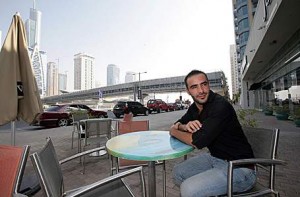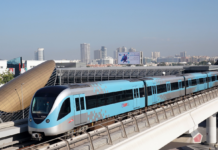Hugh Naylor www.thenational.ae
DUBAI // Were it not for the 14 lanes of superhighway between them, Biloza Farooq would walk to work and possibly stop for coffee at Mohamed Lasfar’s cafe along the way.

Instead, she takes a taxi every morning from her flat in Jumeirah Lake Towers (JLT) directly to Media City, bypassing the Marina and the java u cafe as it struggles for business.
On Wednesday, however, the two sides will be linked by one of the Dubai Metro’s 19 footbridges – and the java u will potentially have a new wave of customers, among them Ms Farooq.
Air-conditioned and equipped with moving walkways and escalators, the hulking bridges, each weighing nearly 200 tonnes, straddle Sheikh Zayed Road and are poised to bring together communities and businesses that, although directly opposite each other, and sometimes no further than a few dozen metres apart, have been so physically separated as to be separate communities.
Nowhere is this more apparent than between Dubai Marina and JLT. Once isolated from each other, they are about to be brought together by two Metro stations and two footbridges.
“It’s going to change a lot of things,” said Ms Farooq, 32, an Indian, whose Lake City Tower home is almost directly in front of a Metro entrance.
An avid walker, in part because she lacks a driving licence, Ms Farooq said she would rather enjoy a leisurely stroll to her job, along the Marina’s ultra-modern high-rise apartment blocks and waterway promenades, than take a taxi.
“It’d be especially nice to walk to work once summer’s over,” she said.
But for now, Ms Farooq is prevented from doing so by the bridge-less Sheikh Zayed Road and its notorious traffic.
Instead, she waits for taxis every morning in the scorching heat, spending roughly Dh30 (US$8) a day on commuting, little more than a mile each way, to her job as an instructor of the GMAT, a US university-system entrance examination.
“In Dubai, what’s expensive is your rent and taxis,” she said. “This will be a welcome change for a lot of people. A colleague of mine spends Dh1,000 a month sharing taxis from her home in Bur Dubai.
“I spend a lot of my salary on cabbies myself, maybe 15 per cent.”
This is music to the ears of Mr Lasfar, java u’s operations manager, whose cafe sits beside the Metro entrance on the Dubai Marina side.
He reckons that people such as Ms Farooq may, from now on, spend what would have been their taxi fare on a coffee or one of the cafe’s breakfast specials after they have walked over from the other side.
“We are the only coffee shop in this street. We have daily customers, which is a sign that people are satisfied,” he said. “In Dubai, there are lots of choices, but here they can eat breakfast, lunch, dinner.”
It is still unclear whether people using the bridges only for access, rather than to use the Metro, will be charged, and Mr Lasfar remains cautious.
A few cafes in the area have recently closed down, apparent victims of the economic slowdown, and he is uncertain if the Metro will reverse this trend.
“Nobody knows right now,” he said.
“When the JBR [Jumeirah Beach Residence] was built, people were calling it ugly, but now it’s the ‘it’ place to go.”
But the prospect of increased walk-in traffic has compelled Mr Lasfar to change his marketing strategy. He recently printed new takeaway menus for the expected rise in business and has introduced a catering service for nearby flats.
He is also is considering taking java u in the other direction – right to Ms Farooq’s and the rest of JLT’s doorsteps. “We’re thinking now we can just send waiters over the bridge with the food, so we don’t have to use motorcycles.”
















